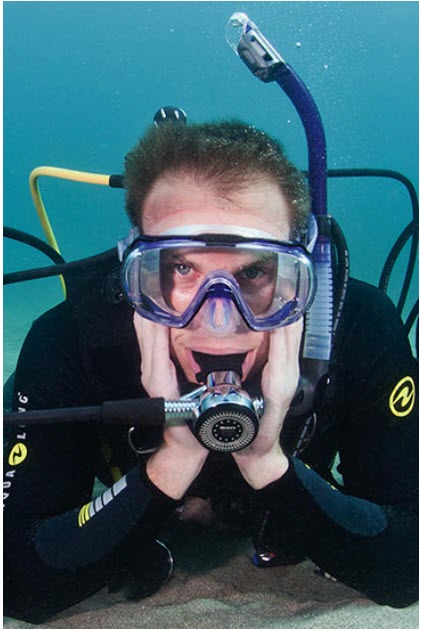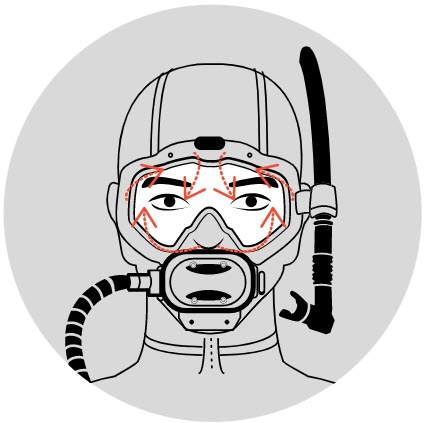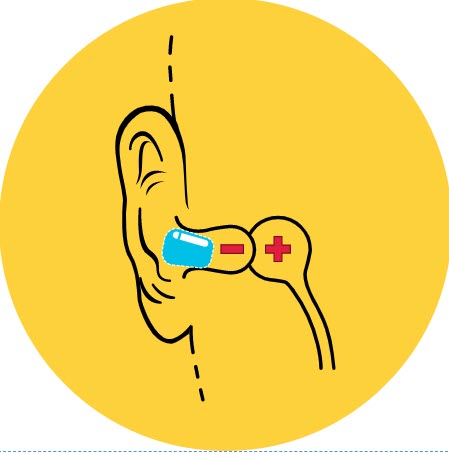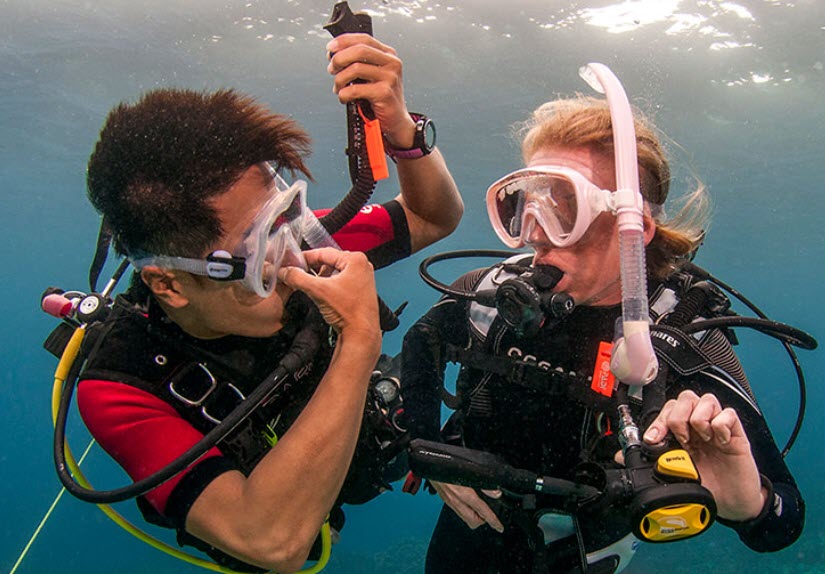Lesson 3
Explanation and video of the effects or pressure on air spaces
By the end of this section, I should be able to answer these questions:
1. What three major body air spaces does increasing pressure affect as I descend?
2. What is a “squeeze”?
3. What is “equalization” and how do I equalize as I descend?
4. How often should I equalize?
5. What should I do if I can’t equalize? What can happen if I don’t or can’t equalize and keep descending?
6. Why should I equalize gently?
7. Why does congestion from a cold or allergy temporarily keep me from diving? Why should I never dive with earplugs?
8. What other body air spaces are affected by increasing pressure? How do I equalize them?
The Effects of Increasing Pressure on Body Air Spaces
Although most of your body is made of water and doesn’t feel increasing pressure, increasing pressure does affect air spaces in and in contact with your body. This is because the pressure compresses the air in the space. As the air volume decreases, water pressure pushes in on body tissues surrounding the space, and you feel it.

The three major body air spaces affected are:
- Ears
- Sinuses
- Mask
If you don’t adjust for increasing pressure compressing a body air space, you can get a squeeze. A squeeze causes discomfort and, if not corrected, can cause injury by pressure imbalance that pushes tissues into an air space. This happens because there is greater pressure outside the air space than inside it. Discomfort in the ears as you descend is from an ear squeeze. It is caused by pressure pushing your eardrum and surrounding tissues inward. A pulling or sucking sensation on your face is from a mask squeeze. Discomfort in your cheeks, central forehead and along the nose is from a sinus squeeze. Other squeezes are possible, but not common.
Equalization

You can easily prevent squeezes. Do this by adding air to the air spaces as you descend. This keeps their pressure equal with the outside pressure, so they stay at their normal volume. This is called equalization. To equalize your ears and sinuses, pinch your nose and blow gently against it. This sends air from your throat into your ears and sinuses. Some people find that wiggling their jaws side to side and swallowing also works. To equalize your mask, blow air into it through your nose as you descend. This is why you can’t use goggles for scuba diving – they don’t enclose your nose, so you can’t equalize them.
Equalize every metre/few feet, before you feel discomfort. If you wait until you feel discomfort, equalization may be difficult or impossible. When you equalize as often as you should, you don’t feel discomfort or pain.
If you can’t equalize, stop your descent immediately. Signal your buddy(ies) or instructor – they have no way of knowing you have an equalization problem unless you tell them. Signal “problem” and point to your ear (you’ll learn these and other hand signals later in this section).
- Ascend slightly until the discomfort passes and try again. Be patient. After you equalize, descend more slowly, equalizing more frequently.
- If you still can’t equalize, stop the dive
Continuing to descend with unequalized air spaces can lead to serious injuries.
Ear injuries include fluid accumulating in the middle ear, and eardrum rupture. Eardrum rupture underwater can cause severe vertigo (dizziness and loss of balance), and requires medical treatment.

An unequalized mask can cause bruising around your eyes. While it’s usually not serious and clears with time, its appearance is dramatic and may be alarming.
A physician should check serious squeezes to avoid long-term injury and complications.
Equalize gently. Never attempt a forceful and/or extended equalization. A forceful, extended equalization can cause serious permanent injuries to your ears and hearing.
- Use short, frequent, gentle equalizations.
- If short, frequent, gentle equalizations don’t work, stop your descent, signal your buddy(ies)/instructor, ascend until the discomfort passes and try again.
With practice, equalizing becomes easier for most people. Never dive with a cold or allergy. They can cause congestion that might block normal air flow and may make equalization of body air passages difficult or impossible. Using cold medications is not recommended. They can wear off during a dive, and can cause equalization problems as you ascend (more about this shortly). Wait until you’re well.

You never use earplugs while diving. They create air spaces that you can’t equalize (the exceptions are special ear protectors made specifically for diving). Similarly, a wet suit hood that seals too tightly against an ear can act like an earplug. If so, pull the hood away from your ear momentarily.

Equalize every metre/few feet, before you feel discomfort. When you equalize as often as you should, you don’t feel discomfort or pain.
Increasing pressure may affect other body air spaces as you descend. It’s very rare, but an air space can develop in filled teeth and cause discomfort. If it happens, stop your descent because you can’t equalize this air space. See your dentist to correct the air space; regular dental checkups help avoid this problem.
A dry suit holds a layer of air around your body during the dive. Increasing pressure compresses this air, but you learn to equalize this space in the PADI Dry Suit Diver course. If you will use a dry suit during this course, your instructor will show you how to equalize it.
Your lungs are a large air space, but scuba provides air at the surrounding pressure. So, you don’t need to do anything special to equalize your lungs other than to breathe normally and continuously. When skin diving (breath-hold diving), your lungs compress as you descend, but they are designed to do this. The only possible concerns are if you were to descend after exhaling completely, or if you were to breath-hold dive, very deep (60 metres/200 feet or more). These are unlikely for most divers.
Lesson quiz
Module One

I'll take you diving!
Copyright © Larry Wedgewood Scuba Instruction All Rights Reserved

